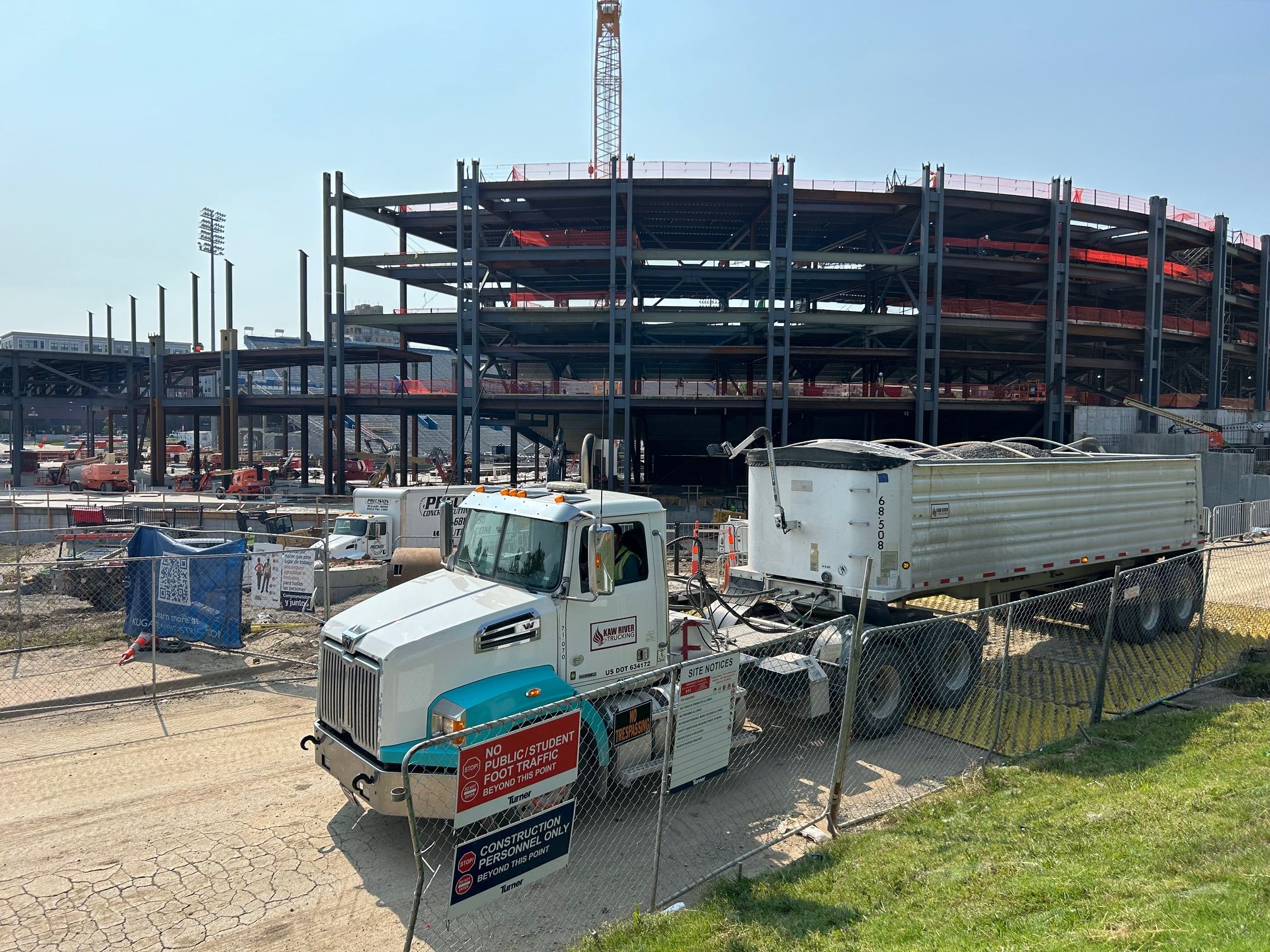Kansas Construction Entrance And Wheel Wash BMP
Kansas Department of Health and Environment (KDHE) Stormwater Permits
The federal 1972 Clean Water Act was established to raise the quality of nation’s surface waters. The Act established the National Pollution Discharge Elimination System (NPDES) permit program which regulates water discharges from construction, industrial, and municipal activities. Construction projects which disturb an area of land equal to one acre or greater must obtain stormwater permit coverage.
In Kansas, the Department of Health and Environment (KDHE) administers the NPDES permit program by reviewing permit applications, issuing permits to site operators, and enforcing the permit requirements. Permit authorizations allow operators to discharge water in accordance with the permit requirements. Many construction operations can obtain permit coverage under the Stormwater Runoff from Construction Activities General Permit S-MCST-1703-1. To obtain permit coverage, operators will submit a Notice of Intent and develop a Stormwater Pollution Prevention Plan (SWPPP, SWP2, or SWP3), also called a Storm Water Management Plan (SMP), to guide the mitigation practices which will be used throughout the project.
The SWPPP includes an outline of all potential sources of pollution on the site. In addition, the plan will describe the techniques and processes which will be used to mitigate or contain these pollutants on the job site. The techniques are referred to as Best Management Practices or BMPs and can include structures, practices, and procedures.
Construction Entrance BMPs
The most common type of water pollutant is sediment which can increase water temperatures and reduce the availability of oxygen. During construction activities the disturbed soils are at risk of rapid erosion which can cause significant sedimentation to water sources. Sediment and erosion control BMPs are implemented to contain sediment within the job site and stabilized disturbed areas to reduce erosion.
The Construction Entrance BMP is one of the first structures to be installed at a job site and must be constructed before grading, clearing and excavation can begin. The purpose of a Construction Entrance is to reduce off-site sediment tracking from construction vehicles onto public roadways where deposited sediment can enter storm drains. In addition to removing sediment from vehicle tires, the entrance area should include a ridge or be graded to provide drainage back to the site to prevent sediment laden runoff from entering the roadway. Various techniques are available and can be combined to increase effectiveness.
For this BMP to effectively contain sediment from construction vehicles, Construction Entrances should be installed consistently throughout every egress point that is used on the job site. In addition, street sweeping or vacuuming should be promptly conducted to capture any sediment and debris that is deposited onto public roadways. In addition, regular inspections and maintenance should be conducted to ensure the entrance is in good condition.
The General Permit states that “off-site sediment tracking should be minimized by using wheel washing facilities or an appropriately designed washing facilities designed construction entrance and exit”, however, further guidance is often provided by the local permit issuing authority. For example, west of Kansas City, Wyandotte County recommends following the KC-AWPA Standards for BMP design.
Aggregate Construction Entrance
An aggregate construction entrance is a traditional design which uses a pad of course rock to stabilized the site exit. The KC-AWPA specifications include a design of an aggregate construction entrance which uses 2” - 3” coarse aggregate installed over a Non-Woven Geotextile filter fabric. The filter fabric is used to prevent sediment seepage from the underlying substrate into the aggregate layer. In this design, the dimensions of pad are recommended at 50’ minimum length and 20’ minimum width with a wide turn radius where the aggregate meets the roadway.
During the course of construction activity, the aggregate pad will become compacted and saturated with sediment which will reduce effectiveness. When the entrance is no longer containing the majority of sediment on the job site, maintenance will be needed to restore the entrance. An aggregate construction exit is maintained by mixing the stone or top dressing with additional rock. In addition to a regular inspection schedule, entrances should be inspected after rain events which can cause entrances to quickly become saturated with sediment.
If the aggregate construction entrance is not sufficient to mitigate sediment tracking, additional or alternative BMPs should be used.
Steel Rumble Plates
The KC-AWPA aggregate construction entrance standards include an optional rumble plate, or shaker plate. The system is typically constructed of a steel structure with raised ridges. Some styles of shaker plates are raised to provide a void below the plates. The ridges are designed to agitate and shake vehicle tires as they exit over the pad. Rumble plates are commonly used in conjunction with an aggregate pad and are placed in the center of the aggregate to supplement the cleaning process.
When sediment fills the voids between the ridges, the plates can be cleaned to restore performance. In raised systems, the plates will need to be removed to excavate the void below.
Wheel Wash Construction Entrance BMP
Wheel Wash systems use pressurized water to spray mud and sediment from vehicles tires. A wheel wash station consists of a wash rack and a pressurized water system. A shaker plate or concrete slab can be used as a wash rack. Wheel wash sprayers can be manually operated or use automated sprayers. When installing a wheel wash station, all wash water must be diverted to a sediment basin or sediment trap to prevent sediment laden water from entering the roadway.
FODS Trackout Control System
The FODS Trackout Control System is a modern construction entrance BMP which is designed to effetely remove sediment from vehicle tires and minimize off site tracking. The system is durable and reusable allowing contractors to reduce costs. The system consists of modular 12’ x 7’ HDPE mats which are formed into pyramids on the surface. The pyramids dislodge sediment and debris by flexing vehicle tires which causes tread lugs to open. Compared to traditional aggregate style entrances, FODS has been shown to reduce street sweeping by 59% on high traffic volume sites.
The FODS system can be installed over a variety of substrates including dirt, concrete or asphalt. The mats are designed to be used as a standalone system without the use of aggregate which can eliminate the risk of loose rock entering the roadway or becoming lodged in dual tire vehicles.
The system can hold 2.5” of sediment between the pyramids before maintenance is required. Maintenance is commonly conducted using a skid steer with a broom attachment or a street sweeper with an adjustable brush. In many cases, the maintenance of the entrance can be conducted as part of the regular street sweeping schedule
Additional Resources
Kansas Construction Stormwater Program
Kansas Construction Stormwater Permit Packet
Kansas Stormwater Runoff from Construction Activities General NPDES Permit

